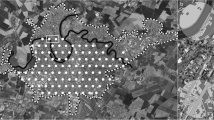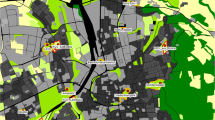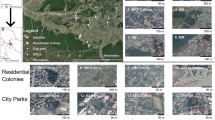Abstract
The desire to improve urban sustainability is motivating many city planners to adopt growth strategies that increase residential density, leading to substantial changes to urban landscapes. What effect this change will have on biodiversity remains unclear, but it is expected that the role of public greenspace in providing wildlife habitat will become critical. We explored the role of urban “pocket parks” as habitat for birds, and how this role changed with increasing residential density in the surrounding neighbourhood. We found that parks in neighbourhoods with high levels of public greenspace (corresponding to less residential land) supported more bird species and individuals overall, and more woodland-dependent species, insectivores and hollow-nesters. Total greenspace area was more important (included in the best ranked models for all bird responses) than the configuration (number, average size and connectivity) of greenspace patches. The majority of species were common suburban birds, indicating that species we assume are tolerant to urban areas will be negatively affected by increasing residential density. Parks form part of an interconnected network of urban open space. For parks to continue to support a diverse native bird community, the network must be viewed, managed, and maintained in its entirety. We suggest three key management actions to improve the bird diversity values of urban greenspaces in compact cities: (1) Increase urban greenspace cover in residential neighbourhoods. (2) Increase vegetation structure in greenspace. (3) Encourage homeowners to plant trees and shrubs.


Similar content being viewed by others
References
ABS 2010. Australian Demographic Statistics, 3101.0, Dec 2010. Australian Bureau of Statistics
Andersson E (2006) Urban landscapes and sustainable cities. Ecol Soc 11:34
Bjornstad ON, Falck W (2001) Nonparametric spatial covariance functions: estimation and testing. Environ Ecol Stat 8:53–70
Blair RB (1996) Land use and avian species diversity along an urban gradient. Ecol Appl 6:506–519
Botequilha Leito A, Miller J, Ahern J, McGarigal K (2006) Measuring landscapes: a planner’s handbook. Island Press, Washington
Bounds J, Taws N, Cunningham RB (2010) A statistical analysis of trends in occupancy rates of woodland birds in the ACT, December 1998 to December 2008: the ten-year data analysis. Canberra Ornithologists Group
Burnham KP, Anderson DR (2002) Model selection and multimodel inference. Springer, New York
Definiens 2008. Definiens Developer 7.0, User Guide
Donald PF, Sanderson FJ, Burfield IJ, van Bommel FPJ (2006) Further evidence of continent-wide impacts of agricultural intensification on European farmland birds, 1990–2000. Agric Ecosyst Environ 116:189–196
1999. Environment Protection and Biodiversity Conservation Act. Cth. 2005. Tree Protection Act. ACT
Fahrig L (2003) Effects of habitat fragmentation on biodiversity. Annu Rev Ecol Syst 34:487–515
Fahrig L, Baudry J, Brotons L, Burel FG, Crist TO, Fuller RJ, Sirami C, Siriwardena GM, Martin J-L (2011) Functional landscape heterogeneity and animal biodiversity in agricultural landscapes. Ecol Lett 14:101–112
Fennell P (ed) (2009) Birds of Canberra gardens. Canberra Ornithologists Group, Canberra
Fischer J, Stott J, Zerger A, Warren G, Sherren K, Forrester RI (2009) Reversing a tree regeneration crisis in an endangered ecoregion. Proc Natl Acad Sci USA Biol Sci 106:10386–10391
Fontana S, Sattler T, Bontadina F, Moretti M (2011) How to manage the urban green to improve bird diversity and community structure. Landsc Urban Plan 101:278–285
Goddard MA, Dougill AJ, Benton TG (2010) Scaling up from gardens: biodiversity conservation in urban environments. Trends Ecol Evol 25:90–98
ACT Government 2006. Design standards for urban infrastructure. 14. Urban Open Space. Territory and Municipal Services, ACT
Hanspach J, Fischer J, Stott J, Stagoll K (2011) Conservation management of eastern Australian farmland birds in relation to landscape gradients. J Appl Ecol 48:523–531
Hostetler M, Holling CS (2000) Detecting the scales at which birds respond to structure in urban landscapes. Urban Ecosyst 4:25–54
Huste A, Boulinier T (2011) Determinants of bird community composition on patches in the suburbs of Paris, France. Biol Conserv 144:243–252
Laurance WF (2008) Theory meets reality: how habitat fragmentation research has transcended island biogeographic theory. Biol Conserv 141:1731–1744
Lim HC, Sodhi NS (2004) Responses of avian guilds to urbanisation in a tropical city. Landsc Urban Plan 66:199–215
Lindenmayer DB, Cunningham RB (2011) Longitudinal patterns in bird reporting rates in a threatened ecosystem: is change regionally consistent? Biol Conserv 144:430–440
Lindenmayer DB, Fischer J (2006) Habitat fragmentation and landscape change. An ecological and conservation synthesis. CSIRO Publishing, Collingwood
Loss SR, Ruiz MO, Brawn JD (2009) Relationships between avian diversity, neighborhood age, income, and environmental characteristics of an urban landscape. Biol Conserv 142:2578–2585
Luck GW, Davidson P, Boxall D, Smallbone L (2011) Relations between urban bird and plant communities and human well-being and connection to nature. Conserv Biol 25:816–826
McCullagh P, Nelder JA (1989) Generalized linear models. Chapman & Hall/CRC, Boca Raton
Montague-Drake R, Lindenmayer DB, Cunningham R (2009) Factors effecting site occupancy by woodland bird species of conservation concern. Biol Conserv 142:2896–2903
Musacchio LR (2009) The scientific basis for the design of landscape sustainability: a conceptual framework for translational landscape research and practice of designed landscapes and the six Es of landscape sustainability. Landscape Ecol 24:993–1013
Myint SW, Gober P, Brazel A, Grossman-Clarke S, Weng Q (2011) Per-pixel vs. object-based classification or urban land cover extraction using high spatial resolution imagery. Remote Sens Environ 115:1145–1161
Oliver AJ, Hong-Wa C, Devonshire J, Olea KR, Rivas GF, Gahl MK (2011) Avifauna richness enhanced in large, isolated urban parks. Landsc Urban Plan 102:215–225
Ortega-Alvarez R, MacGregor-Fors I (2009) Living in the big city: effects of urban land-use on bird community structure, diversity and composition. Landsc Urban Plan 90:189–195
Pauleit S, Ennos R, Golding Y (2005) Modeling the environmental impacts of urban land use and land cover change—a study in Merseyside, UK. Landsc Urban Plan 71:295–310
Rey Benayas JM, Bullock JM, Newton AC (2008) Creating woodland islets to reconcile ecological restoration, conservation and agricultural land use. Front Ecol Environ 6:329–426
Rhodes J, McAlpine C, Zuur A, Smith G, Ieno E (2009) GLMM applied on the spatial distribution of koalas in a fragmented landscape. In: Zuur A (ed) Mixed effects models and extensions in ecology with R. Springer, Berlin
Robertson OJ, Radford JQ (2009) Gap-crossing decisions of forest birds in a fragmented landscape. Austral Ecol 34:435–446
Shwartz A, Shirley S, Kark S (2008) How do habitat variability and management regime shape the spatial heterogeneity of birds within a large Mediterranean urban park? Landsc Urban Plan 84:219–229
Silcocks A, Tzaros C, Weston M, Olsen P (2005) An interim guild classification for woodland and grassland birds in Australia. Birds Australia Supplementary Report to State of the Environment Report 2006, Carlton
Stagoll K, Lindenmayer DB, Knight E, Fischer J, Manning AD (2012) Large trees are keystone structures in urban parks. Conserv Lett 5:115–122
Suarez-Rubio M, Thomlinson JR (2009) Landscape and patch-level factors influence bird communities in an urbanized tropical island. Biol Conserv 142:1311–1321
Sutherland WJ, Newton I, Green RE (2004) Bird ecology and conservation: a handbook of techniques. Oxford University Press, Oxford
Thornton DH, Branch LC, Sunquist ME (2011) The relative influence of habitat loss and fragmentation: do tropical mammals meet the temperate paradigm? Ecol Appl 21:2324–2333
Tratalos J, Fuller RA, Warren PH, Davies RG, Gaston KJ (2007) Urban form, biodiversity potential and ecosystem services. Landsc Urban Plan 83:308–317
Tremblay MA, St. Clair CC (2011) Permeability of a heterogeneous urban landscape to the movements of forest songbirds. J Appl Ecol 48:679–688
United Nations 2009 (2009) Revision of World Urbanization Prospects. In: United Nations Development Programme
United Nations 2011 (2011) Revision of world urbanization prospects. In: United Nations Department of Economic and Social Affairs P. D.
Wiens J (2009) Landscape ecology as a foundation for sustainable conservation. Landscape Ecol 24:1053–1065
Acknowledgments
Thanks to staff from ACT Conservation, Planning and Research, Territory and Municipal Services; Land Development Agency, ACT Planning and Land Authority, and J. Hibberd, P. Barton and P. Lentini for useful discussions; and M. Westgate and I. Stirnemann for providing helpful comments on earlier versions of this paper. K.I. was the recipient of a postgraduate independent research scholarship, jointly funded by the Fenner School of Environment and Society (The Australian National University) and Conservation, Planning and Research (ACT Government). Ethics approval was obtained before conducting this work (F.ES.08.10).
Author information
Authors and Affiliations
Corresponding author
Electronic supplementary material
Below is the link to the electronic supplementary material.
Rights and permissions
About this article
Cite this article
Ikin, K., Beaty, R.M., Lindenmayer, D.B. et al. Pocket parks in a compact city: how do birds respond to increasing residential density?. Landscape Ecol 28, 45–56 (2013). https://doi.org/10.1007/s10980-012-9811-7
Received:
Accepted:
Published:
Issue Date:
DOI: https://doi.org/10.1007/s10980-012-9811-7




